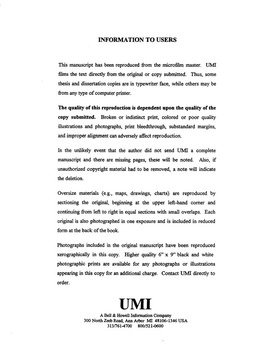| dc.contributor.advisor | Paul, Stephen J., | en_US |
| dc.contributor.author | Gray, Marta E. | en_US |
| dc.date.accessioned | 2013-08-16T12:30:02Z | |
| dc.date.available | 2013-08-16T12:30:02Z | |
| dc.date.issued | 1998 | en_US |
| dc.identifier.uri | https://hdl.handle.net/11244/5639 | |
| dc.description.abstract | The study contains seven chapters and several appendices. Chapter one defines the problem and provides a brief introduction to symbolic interaction theory. Chapter two contains a survey of related literature in the following areas: piano performance and pedagogy, symbolic interaction theory, and dissertations applying symbolic interaction theory to career choice, attitudes, and pedagogical techniques in music education. Chapter three discusses the methodology of the study. Chapter four presents the data gathered during the Spring 1997 semester. The data was interpreted using symbolic interaction theory by level of study in chapter five and by type of degree in chapter six. Chapter seven includes conclusions, implications, recommendations, and suggestions for further research. | en_US |
| dc.description.abstract | Within degree plans, performance majors exhibited the weakest identification with the teaching role; music education/pedagogy majors exhibited the strongest identification with the teaching role. Performance/pedagogy majors revealed a balanced interest in both teaching and performing. However, their teaching interest was focused most strongly upon the traditional performance-oriented private lesson. | en_US |
| dc.description.abstract | Interest in the teaching or performing roles varied according to the level of study and the type of degree undertaken. Undergraduates exhibited the weakest identification with the teaching role; doctoral students exhibited the strongest identification with the teaching role. Masters students revealed a strong interest in the teaching role; however, they were the most interested in educating future performers via the traditional private lesson. | en_US |
| dc.description.abstract | The purpose of this study was to analyze University of Oklahoma piano majors' identification with the roles of teacher and performer. Forty piano majors in residence at the University of Oklahoma during the Spring 1997 semester participated in the study. Data was gathered via questionnaire, group discussions and individual interviews and analyzed using symbolic interaction theory. The study examined the piano majors' definitions of the teaching and performing roles, and the opportunities they had to take the roles of teacher or performer. The piano majors' use of teaching and performing gestures was examined, and an identification was made of their significant others. The strength of the piano majors' reference groups was determined, and their nature was defined. | en_US |
| dc.format.extent | xii, 189 leaves ; | en_US |
| dc.subject | Music in universities and colleges Oklahoma. | en_US |
| dc.subject | Piano Instruction and study Oklahoma. | en_US |
| dc.subject | Music. | en_US |
| dc.subject | College students Oklahoma Psychology. | en_US |
| dc.subject | Education, Music. | en_US |
| dc.title | Teacher or performer: Role identification among piano majors. | en_US |
| dc.type | Thesis | en_US |
| dc.thesis.degree | Ph.D. | en_US |
| dc.thesis.degreeDiscipline | School of Music | en_US |
| dc.note | Major Professor: Stephen J. Paul. | en_US |
| dc.note | Source: Dissertation Abstracts International, Volume: 59-04, Section: A, page: 1104. | en_US |
| ou.identifier | (UMI)AAI9828792 | en_US |
| ou.group | Weitzenhoffer Family College of Fine Arts::School of Music | |
